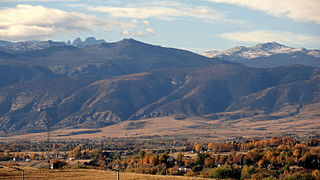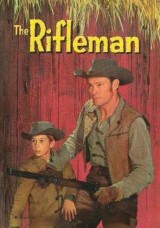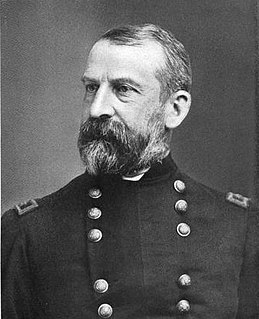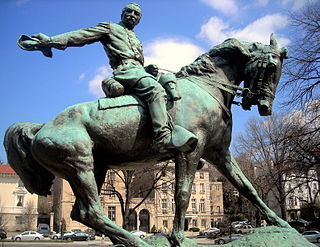Related Research Articles

Sheridan is a city in Yamhill County, Oregon, United States. Platted in the 1860s when it received a post office, the city was incorporated in 1880. A major fire burned much of the city in 1913, and a flood covered much of the city in 1964. The population of the city as of the 2010 Census was 6,127, an increase from 3,570 at the 2000 census. However, the 2000 Census count failed to include those incarcerated at the federal prison in the city, while the newer count did include those inmates.

Sheridan is a city in the U.S. state of Wyoming and the county seat of Sheridan County. The city is located halfway between Yellowstone Park and Mount Rushmore by U.S. Route 14 and 16. It is the principal city of the Sheridan, Wyoming, Micropolitan Statistical Area which encompasses all of Sheridan County. The 2010 census put the city's population at 17,444 and the Sheridan, Wyoming, Micropolitan Statistical Area at 29,116, making it the 421st-most populous micropolitan area in the United States.

Philip Henry Sheridan was a career United States Army officer and a Union general in the American Civil War. His career was noted for his rapid rise to major general and his close association with General-in-chief Ulysses S. Grant, who transferred Sheridan from command of an infantry division in the Western Theater to lead the Cavalry Corps of the Army of the Potomac in the East. In 1864, he defeated Confederate forces under General Jubal Early in the Shenandoah Valley and his destruction of the economic infrastructure of the Valley, called "The Burning" by residents, was one of the first uses of scorched-earth tactics in the war. In 1865, his cavalry pursued Gen. Robert E. Lee and was instrumental in forcing his surrender at Appomattox.

The American Indian Wars, also known as the American Frontier Wars, the First Nations Wars in Canada, and the Indian Wars, were fought by European governments and colonists, and later by the United States and Canadian governments and American and Canadian settlers, against various American Indian and First Nation tribes. These conflicts occurred in North America from the time of the earliest colonial settlements in the 17th century until the early 20th century. The various wars resulted from a wide variety of factors. The European powers and their colonies also enlisted allied Indian tribes to help them conduct warfare against each other's colonial settlements. After the American Revolution, many conflicts were local to specific states or regions and frequently involved disputes over land use; some entailed cycles of violent reprisal.
The Army of the Shenandoah was a Union army during the American Civil War. First organized as the Department of the Shenandoah in 1861 and then disbanded in early 1862, it became most effective after its recreation on August 1, 1864, under Philip Sheridan. Its Valley Campaigns of 1864 rendered the Shenandoah Valley of Virginia unable to produce foodstuffs for the Confederate States Army, a condition which would speed the end of the Civil War.

The Battle of Cedar Creek, or Battle of Belle Grove, fought October 19, 1864, was the culminating battle of the Valley Campaigns of 1864 during the American Civil War. Confederate Lt. Gen. Jubal Early launched a surprise attack against the encamped army of Union Maj. Gen. Philip Sheridan, across Cedar Creek, northeast of Strasburg, Virginia. During the morning fighting, seven Union infantry divisions were forced to fall back and lost numerous prisoners and cannons. Early failed to continue his attack north of Middletown, and Sheridan, dramatically riding to the battlefield from Winchester, was able to rally his troops to hold a new defensive line. A Union counterattack that afternoon routed Early's army.

Kalorama is a neighborhood in Northwest Washington, D.C., United States. It includes the Kalorama Triangle Historic District and Sheridan-Kalorama Historic District. It is named after the Kalorama mansion.
The Valley campaigns of 1864 began as operations initiated by Union Lieutenant General Ulysses S. Grant and resulting battles that took place in the Shenandoah Valley of Virginia during the American Civil War from May to October 1864. Some military historians divide this period into three separate campaigns. This article considers them together, as these campaigns interacted and built upon each other.

The Rifleman is an American Western television program starring Chuck Connors as rancher Lucas McCain and Johnny Crawford as his son Mark McCain. It was set in the 1880s in the fictional town of North Fork, New Mexico Territory. The show was filmed in black and white, in half-hour episodes. The Rifleman aired on ABC from September 30, 1958, to April 8, 1963, as a production of Four Star Television. It was one of the first primetime series on US television to show a single parent raising a child.

George Washington Thornton Beck was a politician and business entrepreneur in the U.S. state of Wyoming.

Fort Supply was a United States Army post established on November 18, 1868, in Indian Territory to protect the Southern Plains. It was located just east of present-day Fort Supply, Oklahoma, in what was then the Cherokee Outlet.

Martin John Sheridan was a three time Olympic Games gold medallist. He was born in Bohola, County Mayo, Ireland, and died in St. Vincent's Hospital in Manhattan, New York, the day before his 37th birthday, a very early casualty of the 1918 flu pandemic. He is buried in Calvary Cemetery, Queens, New York. He was part of a group of Irish-American athletes known as the "Irish Whales".

William W. Wells, Jr. was a businessman, politician, and general in the Union Army during the American Civil War who received a Medal of Honor for gallantry at the Battle of Gettysburg.

Daniel Alden Reed was an American football player, coach, and U.S. Representative from the state of New York. Reed was attorney for the excise department of New York from 1903 to 1909. He served in the House of Representatives as a Republican from 1919 until his death in Washington, D.C., on February 19, 1959.

Sheridan Circle is a traffic circle in the Washington, D.C. neighborhood of Embassy Row.

The Wrecker (1892) is an ocean adventure novel written by Robert Louis Stevenson in collaboration with his stepson Lloyd Osbourne.

Washington Park Race Track was a popular horse racing venue in the Chicago metropolitan area from 1884 until 1977. It had two locations during its existence. It was first situated in what is the current location of the Washington Park Subdivision of the Woodlawn community area of Chicago in Cook County, Illinois, United States. This is located immediately south of both the current Washington Park community area and Washington Park. The track was later relocated to Homewood, Illinois, which is also in Cook County.

General Philip Sheridan is a bronze sculpture that honors Civil War general Philip Sheridan. The monument was sculpted by Gutzon Borglum, best known for his design of Mount Rushmore. Dedicated in 1908, dignitaries in attendance at the unveiling ceremony included President Theodore Roosevelt, members of the President's cabinet, high-ranking military officers and veterans from the Civil War and Spanish–American War. The equestrian statue is located in the center of Sheridan Circle in the Sheridan-Kalorama neighborhood of Washington, D.C. The bronze statue, surrounded by a plaza and park, is one of eighteen Civil War monuments in Washington, D.C., which were collectively listed on the National Register of Historic Places in 1978. The sculpture and surrounding park are owned and maintained by the National Park Service, a federal agency of the Interior Department.
John Clancy was an American soldier who served with the 1st Artillery Regiment. He was awarded the Medal of Honor for bravery at the Battle of Wounded Knee, now called the Wounded Knee Massacre.

A general election was held in the U.S. state of Wyoming on Tuesday, November 8, 1910. All of the state's executive officers—the Governor, Secretary of State, Auditor, Treasurer, and Superintendent of Public Instruction—were up for election. Former U.S. Senator Joseph M. Carey won the gubernatorial election, securing the first Democratic win for Governor since 1892. Democratic candidates unseated Republican incumbents in the elections for Secretary of State and Superintendent of Public Instruction, and Republicans narrowly held open seats in elections for State Auditor and Treasurer.
